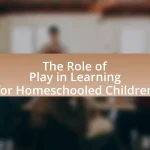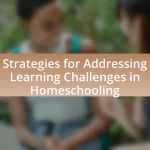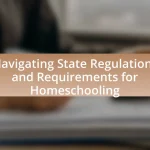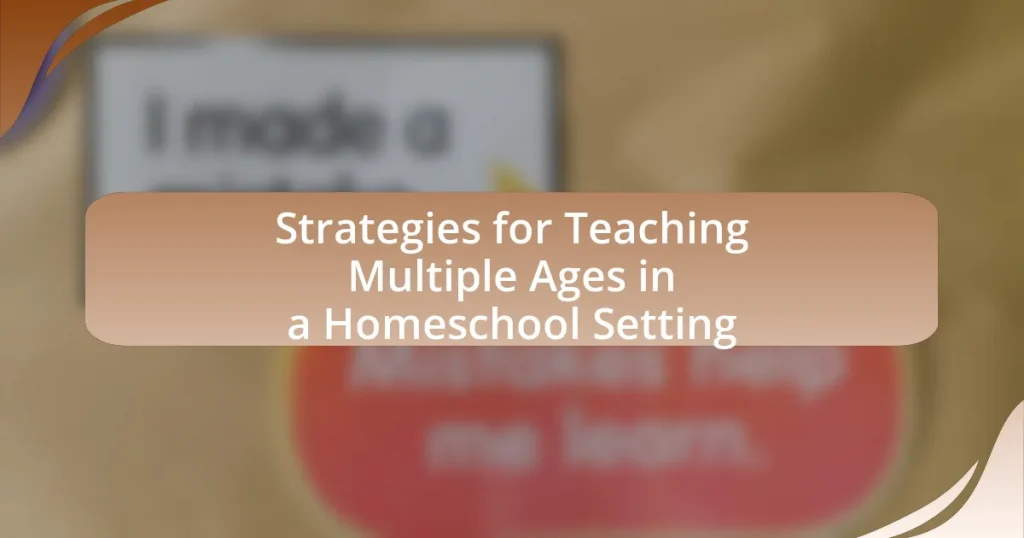The article focuses on effective strategies for teaching multiple ages in a homeschool setting, emphasizing approaches such as unit studies, mixed-age group activities, and the use of online resources. It discusses how parents can manage different learning styles by employing varied teaching methods and adapting curricula to accommodate diverse educational needs. Key components include creating a structured learning environment, balancing individual and group activities, and utilizing community resources to enhance learning. The article also addresses common challenges faced by parents, such as time management and resource limitations, while providing best practices to foster collaboration and maintain motivation among siblings.
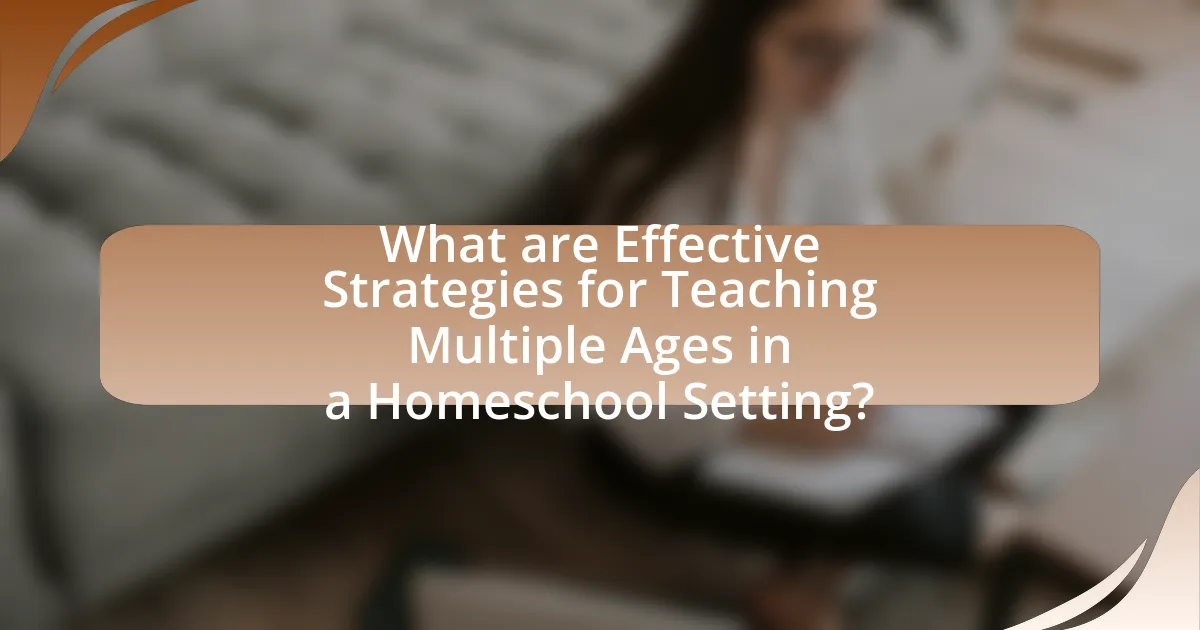
What are Effective Strategies for Teaching Multiple Ages in a Homeschool Setting?
Effective strategies for teaching multiple ages in a homeschool setting include using a unit study approach, incorporating mixed-age group activities, and utilizing online resources. The unit study approach allows families to explore a single topic across different subjects, making it accessible for various age groups simultaneously. Mixed-age group activities foster collaboration and peer learning, where older children can assist younger ones, enhancing understanding for both. Additionally, online resources provide tailored educational content that can cater to different learning levels, ensuring that each child receives appropriate challenges and support. These strategies are validated by educational research indicating that collaborative learning and thematic instruction can improve engagement and retention across diverse age groups.
How can parents manage different learning styles in a homeschool environment?
Parents can manage different learning styles in a homeschool environment by employing a variety of teaching methods tailored to individual preferences. For instance, they can incorporate visual aids, hands-on activities, and auditory resources to address the diverse ways children absorb information. Research indicates that students retain information better when instruction aligns with their preferred learning style; for example, a study published in the “Journal of Educational Psychology” found that students who received instruction in their preferred modality performed significantly better on assessments. By regularly assessing each child’s learning style and adapting lessons accordingly, parents can create a more effective and engaging educational experience.
What are the various learning styles that may be present among children?
Children may exhibit various learning styles, including visual, auditory, kinesthetic, and reading/writing preferences. Visual learners benefit from diagrams, charts, and images, while auditory learners grasp information better through listening and discussions. Kinesthetic learners engage through hands-on activities and movement, and reading/writing learners prefer interacting with text. Research by Fleming and Mills (1992) introduced the VARK model, which categorizes these learning styles, emphasizing the importance of tailoring educational approaches to accommodate diverse preferences for effective learning outcomes.
How can teaching methods be adapted to accommodate these learning styles?
Teaching methods can be adapted to accommodate different learning styles by incorporating a variety of instructional strategies that cater to visual, auditory, and kinesthetic learners. For instance, visual learners benefit from the use of diagrams, charts, and videos, while auditory learners thrive through discussions, lectures, and audio materials. Kinesthetic learners engage better with hands-on activities, experiments, and movement-based learning. Research indicates that differentiated instruction, which tailors teaching approaches to individual learning preferences, enhances student engagement and retention (Tomlinson, 2001). By integrating these diverse methods, educators can create a more inclusive learning environment that meets the needs of all students.
What role does curriculum selection play in teaching multiple ages?
Curriculum selection is crucial in teaching multiple ages as it ensures that educational content is appropriate, engaging, and accessible for diverse learning levels. A well-chosen curriculum accommodates varying developmental stages, allowing educators to tailor lessons that meet the needs of both younger and older students simultaneously. For instance, using thematic units can integrate subjects like science and art, enabling students of different ages to explore the same topic at their respective levels of understanding. Research indicates that differentiated instruction, supported by a carefully selected curriculum, enhances learning outcomes across age groups, as it fosters collaboration and peer learning, which are essential in a multi-age classroom setting.
What types of curricula are best suited for multi-age homeschooling?
The best types of curricula for multi-age homeschooling are those that are flexible, integrated, and project-based. Flexible curricula allow for varying levels of difficulty, enabling children of different ages to learn together while addressing their individual needs. Integrated curricula combine subjects, such as science and history, allowing for thematic learning that engages multiple age groups simultaneously. Project-based curricula encourage collaboration and hands-on learning, fostering critical thinking and problem-solving skills across different ages. Research indicates that these approaches enhance engagement and retention, making them effective for multi-age settings.
How can parents integrate subjects across different age groups?
Parents can integrate subjects across different age groups by using thematic units that encompass various disciplines, allowing children to explore interconnected concepts. For example, a unit on “Weather” can include science (studying meteorological phenomena), geography (understanding climate zones), and art (creating weather-related projects). This approach fosters collaboration and discussion among siblings of different ages, enhancing learning through shared experiences. Research indicates that thematic learning can improve retention and engagement, as it allows students to see the relevance of what they are learning in a broader context.
How can parents create a structured learning environment for multiple ages?
Parents can create a structured learning environment for multiple ages by implementing a flexible schedule that accommodates different learning paces and styles. This can be achieved by designating specific time blocks for group activities, individual study, and collaborative projects, allowing each child to engage at their own level while still participating in shared learning experiences. Research indicates that mixed-age learning fosters social skills and peer teaching, enhancing the educational experience for all ages involved. For instance, a study published in the “Journal of Educational Psychology” found that children in multi-age classrooms demonstrated improved problem-solving skills and greater motivation to learn.
What are the key components of an effective homeschool schedule?
An effective homeschool schedule includes structured time blocks, flexibility, and a balance of subjects. Structured time blocks help establish a routine, allowing students to know what to expect each day, which enhances focus and productivity. Flexibility is crucial as it accommodates the varying needs and learning paces of multiple ages, enabling adjustments for individual learning styles or unexpected events. A balance of subjects ensures that students receive a well-rounded education, incorporating core subjects like math and language arts alongside creative and physical activities, which research shows can improve overall engagement and retention of information.
How can parents balance individual and group learning activities?
Parents can balance individual and group learning activities by scheduling dedicated time for both types of learning within their homeschooling framework. For instance, they can allocate specific days or time blocks for group activities, such as collaborative projects or discussions, while reserving other times for individualized study, allowing children to focus on their personal learning needs. Research indicates that children benefit from both collaborative learning, which enhances social skills and teamwork, and individual learning, which fosters self-paced mastery of subjects. A study published in the “Journal of Educational Psychology” by Johnson and Johnson (2014) highlights that effective balance leads to improved academic performance and social development.

What are the Challenges of Teaching Multiple Ages in a Homeschool Setting?
Teaching multiple ages in a homeschool setting presents challenges such as varying educational needs, attention distribution, and curriculum alignment. Each child may require different teaching methods and materials, making it difficult to create a cohesive lesson plan. Additionally, the educator must balance time effectively to ensure that all children receive adequate attention, which can lead to frustration and burnout. Research indicates that families often struggle with these dynamics, as highlighted in studies on homeschooling practices, which show that managing diverse age groups can complicate instructional delivery and assessment.
What common obstacles do parents face when homeschooling multiple children?
Parents face several common obstacles when homeschooling multiple children, including time management, individualized instruction, and resource allocation. Time management becomes challenging as parents must balance the educational needs of each child while also managing household responsibilities. Individualized instruction is difficult because each child may have different learning styles and paces, requiring tailored approaches that can be time-consuming to develop. Resource allocation is another obstacle, as parents need to ensure they have sufficient materials and space for each child’s learning activities, which can strain budgets and physical environments. These challenges are frequently reported by homeschooling families, highlighting the complexities involved in effectively educating multiple children simultaneously.
How can time management issues be addressed in a multi-age setting?
Time management issues in a multi-age setting can be addressed by implementing structured schedules that accommodate varying age groups and learning paces. Establishing a clear daily routine allows for designated time slots for different subjects, ensuring that each age group receives focused attention while minimizing distractions. Research indicates that structured environments enhance learning outcomes; for example, a study published in the “Journal of Educational Psychology” found that students in organized settings showed improved time management skills and academic performance. Additionally, utilizing tools such as timers and visual schedules can help students understand time allocation, fostering independence and responsibility in managing their own learning.
What strategies can help maintain engagement among different age groups?
To maintain engagement among different age groups in a homeschool setting, employing differentiated instruction is essential. This strategy involves tailoring teaching methods and materials to accommodate the varying learning styles and developmental stages of each age group. For instance, younger students may benefit from hands-on activities and visual aids, while older students might engage more with discussions and independent projects. Research indicates that differentiated instruction can lead to improved student motivation and achievement, as it addresses individual needs and interests, fostering a more inclusive learning environment.
How can parents overcome resource limitations in a multi-age homeschool?
Parents can overcome resource limitations in a multi-age homeschool by utilizing shared resources and collaborative learning strategies. By integrating subjects that allow for group activities, such as science experiments or literature discussions, parents can engage multiple age groups simultaneously, maximizing the use of available materials. Additionally, parents can leverage online resources, such as free educational websites and community programs, to supplement their curriculum without incurring extra costs. Research indicates that collaborative learning not only enhances understanding but also fosters social skills among children of different ages, making it an effective strategy in multi-age settings.
What are some cost-effective resources for multi-age homeschooling?
Cost-effective resources for multi-age homeschooling include online platforms like Khan Academy, which offers free educational materials across various subjects and grade levels. Additionally, the use of public library resources provides access to a wide range of books and educational programs at no cost. Community co-ops can also be a valuable resource, allowing families to share teaching responsibilities and materials, thereby reducing individual costs. Furthermore, websites like Teachers Pay Teachers offer affordable lesson plans and activities created by educators, which can be tailored for different age groups. These resources collectively support diverse learning needs while minimizing expenses.
How can parents utilize community resources to enhance learning?
Parents can utilize community resources to enhance learning by engaging with local libraries, museums, and educational programs. These institutions often provide free or low-cost access to a wealth of educational materials, workshops, and events tailored for various age groups. For instance, many libraries offer reading programs and STEM workshops that cater to different learning levels, allowing parents to supplement their homeschooling curriculum effectively. Additionally, community centers frequently host classes and activities that promote social interaction and practical skills, which are essential for holistic education. By leveraging these resources, parents can create a diverse and enriching learning environment that supports the educational needs of multiple ages simultaneously.

What Best Practices Can Enhance Multi-Age Homeschooling?
To enhance multi-age homeschooling, implementing differentiated instruction is essential, as it allows educators to tailor lessons to meet the diverse learning needs of students across various ages. This approach fosters an inclusive environment where older students can mentor younger ones, promoting collaborative learning. Research indicates that mixed-age classrooms can improve social skills and academic performance, as seen in studies conducted by the National Center for Education Statistics, which highlight the benefits of peer learning and engagement in multi-age settings. Additionally, utilizing thematic units can unify learning objectives, enabling students of different ages to explore the same topic at their respective levels, thereby maximizing engagement and comprehension.
How can parents foster collaboration among siblings during lessons?
Parents can foster collaboration among siblings during lessons by implementing group activities that require teamwork and shared problem-solving. For instance, assigning projects that necessitate input from each sibling encourages them to communicate and collaborate effectively. Research indicates that cooperative learning strategies enhance social skills and academic performance, as demonstrated in studies by Johnson and Johnson, which highlight the benefits of peer interaction in educational settings. By creating an environment where siblings must work together, parents can strengthen their relationships and improve their learning outcomes.
What group activities can promote teamwork and learning?
Group activities that can promote teamwork and learning include collaborative projects, team-building exercises, and group discussions. Collaborative projects, such as science experiments or art creations, require participants to work together, fostering communication and problem-solving skills. Team-building exercises, like trust falls or obstacle courses, enhance interpersonal relationships and encourage reliance on one another. Group discussions, particularly on educational topics, stimulate critical thinking and allow for diverse perspectives, enriching the learning experience. Research indicates that cooperative learning strategies can lead to improved academic performance and social skills, as demonstrated in studies by Johnson and Johnson, which highlight the effectiveness of teamwork in educational settings.
How can parents encourage peer teaching among siblings?
Parents can encourage peer teaching among siblings by creating opportunities for collaborative learning. This can be achieved by assigning projects that require siblings to work together, allowing older siblings to explain concepts to younger ones, and fostering an environment where questions and discussions are welcomed. Research indicates that peer teaching enhances understanding and retention of information, as older siblings often reinforce their own knowledge while teaching younger ones. This method not only strengthens family bonds but also promotes critical thinking and communication skills among siblings.
What tips can help parents maintain motivation in a multi-age homeschool?
To maintain motivation in a multi-age homeschool, parents should establish a flexible schedule that accommodates the varying needs and learning paces of different age groups. This approach allows for individualized attention and fosters a positive learning environment. Additionally, incorporating hands-on activities and collaborative projects can engage all age levels, making learning more dynamic and enjoyable. Research indicates that multi-age classrooms can enhance social skills and peer learning, which further motivates students. By creating a supportive community and celebrating small achievements, parents can sustain enthusiasm and commitment to the homeschooling journey.
How can goal-setting be effectively implemented for different ages?
Goal-setting can be effectively implemented for different ages by tailoring the approach to the cognitive and emotional development of each age group. For young children, using simple, clear, and visual goals, such as stickers or charts, helps them understand and track their progress. Research indicates that children aged 5-7 benefit from concrete rewards and immediate feedback, which reinforces their motivation (Schunk, 2003).
For pre-teens, goal-setting can involve more complex tasks, encouraging them to set SMART (Specific, Measurable, Achievable, Relevant, Time-bound) goals. This age group, typically 9-12 years old, can handle abstract thinking, making it effective to involve them in the goal-setting process, allowing them to reflect on their interests and aspirations (Zimmerman, 2002).
Teenagers, aged 13-18, can be engaged in setting long-term goals that align with their future aspirations, such as college or career plans. This demographic benefits from self-regulation strategies and peer support, as studies show that social influences can significantly impact their motivation and goal achievement (Schunk & Zimmerman, 2008).
By adapting the goal-setting process to the developmental stages of children and teens, educators can enhance motivation and foster a sense of ownership in their learning journey.
What are some fun and engaging ways to celebrate learning milestones?
Celebrating learning milestones can be done through various fun and engaging activities such as hosting a themed party, creating a showcase of student work, or organizing a field trip related to the subject learned. These activities not only acknowledge the achievement but also foster a sense of community and motivation among learners. For instance, a themed party can include decorations and activities that reflect the subject matter, while a showcase allows students to present their projects to family and friends, reinforcing their learning. Research indicates that celebrations can enhance motivation and retention of knowledge, making these methods effective in a homeschool setting.
What are the key takeaways for successfully teaching multiple ages at home?
Successfully teaching multiple ages at home requires a structured approach that accommodates diverse learning needs. Implementing a flexible curriculum allows for individualized learning paths, enabling each child to progress at their own pace while still engaging in group activities. Utilizing multi-age resources, such as thematic units or project-based learning, fosters collaboration and peer learning, enhancing social skills and knowledge retention. Establishing a consistent routine helps manage time effectively, ensuring that each age group receives adequate attention. Research indicates that mixed-age learning environments can improve social development and academic outcomes, as children learn from one another and develop empathy.

